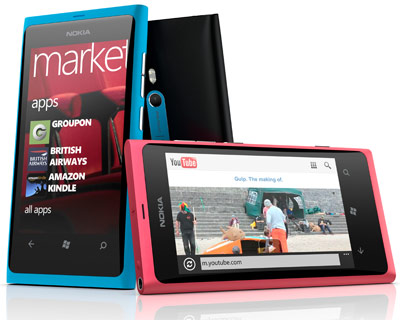Nokia’s first Windows phone looks good: Now for the hard part
 It’s called the Lumia 800 — wasn’t that an early-90s minivan? — and it looks good, as far as these things go.
It’s called the Lumia 800 — wasn’t that an early-90s minivan? — and it looks good, as far as these things go.
Now Nokia and Microsoft need to figure out how to sell it to people who already have plenty of options for smartphones from the Apple and Android camps. This won’t be easy.
Key questions:
- Why should any person buy this instead of an iPhone or the preferred Android phone du jour? Does it solve any problems that other phones don’t? Is there any must-have synergy between a Windows phone and a Windows computer? Or an Xbox? (Or in the future, a Windows tablet?)
- Why should carriers favor Windows phones over Android or Apple phones, in either their in-store sales techniques and marketing? There is no consumer pull and, as far as I can tell, no economic advantage.
- Why should carriers or consumers favor Nokia Windows phones over similar Windows phones from Samsung, HTC, etc.? Will Nokia be doing special advertising? Do they run unique software that makes them better? It’s not like there is any aspirational or luxury value to the Nokia brand. So far the answer seems to be “colors”. Or perhaps Nokia still has a serious distribution advantage in some areas of the world?
- Why should developers make apps for Windows or Nokia phones? Some could be persuaded with cash. But others will want to know where the huge user base to sell apps to is hiding. This chicken-and-egg problem isn’t easily solvable.
The big problem is that Microsoft and Nokia still have not demonstrated any compelling, tangible advantages over the iOS and Android platforms. Sure, you could argue that Windows Phone software looks better than Android. But as Microsoft knows well, that was rarely enough to get people to switch to a Mac from Windows. It just doesn’t do enough that’s seriously better or cooler or simpler or cheaper or different than other phones, in a way that would convince a serious number of people to switch.
For context, how did Apple and Google solve these problems?
- In Apple’s case, the first iPhone was a complete leapfrog over everything else on the market, both in software and hardware. Then Apple continued to improve the iPhone in major ways — App Store, iPad, retina display, camera, and now Siri, iMessage, and iCloud — that made the platform even more desirable over time.
- In Google’s case, Android was the first opportunity most carriers and handset makers had to offer a phone even approaching Apple’s level of quality. People found them “good enough” when the iPhone wasn’t available, and some even prefer them over the iPhone for one reason or another. (Today, for instance, because they are available in 4G varieties, in huge-screen varieties, with keyboards, and on carriers that don’t sell the iPhone, like T-Mobile.)
So pretty much everyone — especially the carriers — rewrote their strategies around Android, and, when available, the iPhone. And so far, Microsoft has not offered anything compelling enough to disrupt that balance. It doesn’t seem to be attacking at either the high- or low-end of the market, or have any noticeably distinct strategy yet. It’s just there, not really making much noise.
It would be great to see a real competition between Apple, Google, Microsoft, and even RIM. But so far, Google and Apple are running away with the market, RIM is watching itself deflate, and Microsoft hasn’t found the answer to the “why?” question. If Android had done something catastrophic to itself, Windows phones might have a chance. But for now, I still don’t see an opening in the market for Microsoft.
Also: Will the tablet market really grow bigger than the PC market?

Check out my new site: The New Consumer, a publication about how and why people spend their time and money.

